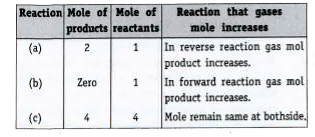Does the number of moles of reaction products increase, decrease or remain same when each of the following equilibria is subjected to a decrease in pressure by increasing the volume?
(a)PCl5(g)⇔PCl3(g)+Cl2(g)
(b)CaO(s)+CO2(g)⇔CaCO3(s)
(c)3Fe(s)+4H2O(g)⇔Fe3O4(s)+4H2(g)
(a)PCl5(g)⇔PCl3(g)+Cl2(g) increase
(b)CaO(s)+CO2(g)⇔CaCO3(s) decrease
(c) 3Fe(s)+4H2O(g)⇔Fe3O4(s)+4H2(g) no change .
Because, the pressure is decreases so, the reaction occurs towards the less mol of gas phase to high mol means reaction take place in such way moles of gases phase increases.

Topper's Solved these Questions
- EQUILIBRIUMBOOK - KUMAR PRAKASHANCHAPTER - EQUILIBRIUMEXERCISE - SECTION-A Try Your self -2
6 Videos
- EQUILIBRIUMBOOK - KUMAR PRAKASHANCHAPTER - EQUILIBRIUMEXERCISE - SECTION-A Try Your self -3
10 Videos
- ENVIRONMENT CHEMISTRY BOOK - KUMAR PRAKASHANCHAPTER - ENVIRONMENT CHEMISTRY EXERCISE - Question For Module (Section-C)
1 Videos
- HYDROCARBONSBOOK - KUMAR PRAKASHANCHAPTER - HYDROCARBONSEXERCISE - (Questions for Module (Section - D))
1 Videos
Similar Questions
Does the number of moles of reaction products increase, decrease, or remain same when each of the following equilibrium is subjected to a decrease in pressure by increasing the volume?
a. PCl5(g)⇔PCl3(g)+Cl2(g)
b. CaO(s)+CO2(g)⇔CaCO3(s)
c. 3Fe(s)+4H2O(g)⇔Fe3O4(s)+4H2(g)
View SolutionDoes the number of moles of reaction products increase, decrease, or remain same when each of the following equilibrium is subjected to a decrease in pressure by increasing the volume?
a. PCl5(g)⇔PCl3(g)+Cl2(g)
b. CaO(s)+CO2(g)⇔CaCO3(s)
c. 3Fe(s)+4H2O(g)⇔Fe3O4(s)+4H2(g)
View Solution
Knowledge Check
Which of the following equilibrium will shift left on increasing pressure ?
(i) CO(g)+H2(g)⇔CO2(g)+H2(g)
(ii) C(s,diamond)⇔C(s,graphite)
(iii) CaCO3(s)⇔CaO(s)+CO2(g)AOnly (i)BOnly (iii)CBoth (ii) and (iii)DNoneFor the reaction :
CaCO3(s)⇔CaO(s)+CO2(g)AKp=p(CaCO3)BKp=p(CO2)CKp=1p(CaCO3)DKp=1p(CO2)In which of the following reactions, the system will shift towards the forward reaction by adding inert gas at constant pressure ?
(a) PCl5(g)⇔PCl3(g)+Cl2(g)
(b) N2(g)+3H2(g)⇔2NH3(g)
(c ) COCl2(g)⇔CO(g)+Cl2(g)
(d) CO(g)+2H2(g)⇔CH3OH(g)Aa, bBb, dCc, dDa, c
Does the number of moles of reaction products increase, decrease or remain the same when each of the following equilibria is subjected to a decrease (⏐↓) in pressure (by increasing (↑⏐) volume)?
(a) 2CO(g)<⇒C(s)+CO2(g)
(b) N2O4(g)<⇒2NO2(g)
(c) CaO(s)+CO2(g)<⇒CaCO3(s)
(d) 3Fe(s)+4H2O(g)<⇒Fe3O4(s)+4H2(g)
View SolutionPredict the effect of pressure on the following equilibria :
(i)2Cu(NO3)2(s)⇔2CuO(s)+4NO2(g)+O2(g)
(ii)C(s)+CO2(g)⇔2CO(g)
(iii)I2(g)+5F2(g)⇔2IF5(g)
(iv)FeO(s)+CO(g)⇔Fe(s)+CO2(g)
View SolutionWhat will be the effect of increased pressure on the following equilibria?
(a) H2(g)+I2(g)⇔2HIg
(b) N2(g)+3H2(g)⇔2NH3(g)
(c) 2SO2(g)+O2(g)⇔2SO3(g)
(d) 2O3(g)⇔3O2(g)
(e) N2O4⇔2NO2(g)
View SolutionDerive units for KC for the following equilibria.
(i)CaCO3(s)⇒CaO(s)+CO2(g)
(ii) PCl3(g)+Cl2(g)⇒PCl5(g)
(iii) N2(g)+O2(g)⇒2NO(g)
View SolutionConsider the reactions
(i)PCl5(g)⇔PCl3(g)+Cl2(g)
(ii)N2O4(g)⇔2NO2(g)
The addition of an inert gas at constant volume
View Solution
